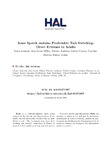Inner speech sustains predictable task switching: direct evidence in adults
| dc.contributor.author | Laurent, L | |
| dc.contributor.author | Millot, J-L | |
| dc.contributor.author | Andrieu, P | |
| dc.contributor.author | Camos, V | |
| dc.contributor.author | Floccia, Caroline | |
| dc.contributor.author | Mathy, F | |
| dc.date.accessioned | 2017-09-18T12:56:30Z | |
| dc.date.available | 2017-09-18T12:56:30Z | |
| dc.date.issued | 2016-07-03 | |
| dc.identifier.issn | 2044-5911 | |
| dc.identifier.issn | 2044-592X | |
| dc.identifier.uri | http://hdl.handle.net/10026.1/9944 | |
| dc.description.abstract |
It has been proposed that inner speech supports task selection in task-switching studies, especially when the need for endogenous control is increased. This has been established through the suppression of inner speech in cognitive-flexibility tasks that leads to poorer performance. The aim of this study is to quantify the role of inner speech in a flexibility task by using surface laryngeal electromyography, which, contrary to previous studies, enables participants to freely verbalise the tasks. We manipulated endogenous and exogenous flexibility in a mathematical switching task paradigm. Experiment 1 shows that inner speech acts as a support for switching and is recruited more often when the tasks are of an endogenous type. The main result of Experiment 2 that language is recruited more for the mixing cost than for the switch cost (regardless of the endogenous factor) extends past findings obtained through articulatory suppression. | |
| dc.format.extent | 585-592 | |
| dc.language | en | |
| dc.language.iso | en | |
| dc.publisher | Informa UK Limited | |
| dc.subject | Task switching | |
| dc.subject | cognitive control | |
| dc.subject | inner speech | |
| dc.subject | language | |
| dc.subject | electromyography | |
| dc.title | Inner speech sustains predictable task switching: direct evidence in adults | |
| dc.type | journal-article | |
| dc.type | Journal Article | |
| plymouth.author-url | https://www.webofscience.com/api/gateway?GWVersion=2&SrcApp=PARTNER_APP&SrcAuth=LinksAMR&KeyUT=WOS:000383552100005&DestLinkType=FullRecord&DestApp=ALL_WOS&UsrCustomerID=11bb513d99f797142bcfeffcc58ea008 | |
| plymouth.issue | 5 | |
| plymouth.volume | 28 | |
| plymouth.publication-status | Published | |
| plymouth.journal | Journal of Cognitive Psychology | |
| dc.identifier.doi | 10.1080/20445911.2016.1164173 | |
| plymouth.organisational-group | /Plymouth | |
| plymouth.organisational-group | /Plymouth/Faculty of Health | |
| plymouth.organisational-group | /Plymouth/Faculty of Health/School of Psychology | |
| plymouth.organisational-group | /Plymouth/REF 2021 Researchers by UoA | |
| plymouth.organisational-group | /Plymouth/REF 2021 Researchers by UoA/UoA04 Psychology, Psychiatry and Neuroscience | |
| plymouth.organisational-group | /Plymouth/REF 2021 Researchers by UoA/UoA04 Psychology, Psychiatry and Neuroscience/UoA04 REF peer reviewers | |
| plymouth.organisational-group | /Plymouth/Research Groups | |
| plymouth.organisational-group | /Plymouth/Research Groups/Centre for Brain, Cognition and Behaviour (CBCB) | |
| plymouth.organisational-group | /Plymouth/Research Groups/Centre for Brain, Cognition and Behaviour (CBCB)/Cognition | |
| plymouth.organisational-group | /Plymouth/Research Groups/Plymouth Institute of Health and Care Research (PIHR) | |
| plymouth.organisational-group | /Plymouth/Users by role | |
| plymouth.organisational-group | /Plymouth/Users by role/Academics | |
| dc.identifier.eissn | 2044-592X | |
| dc.rights.embargoperiod | No embargo | |
| rioxxterms.versionofrecord | 10.1080/20445911.2016.1164173 | |
| rioxxterms.licenseref.uri | http://www.rioxx.net/licenses/all-rights-reserved | |
| rioxxterms.type | Journal Article/Review |


